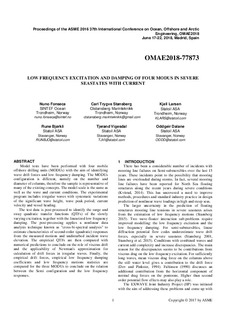| dc.contributor.author | Fonseca, Nuno | |
| dc.contributor.author | Stansberg, Carl Trygve | |
| dc.contributor.author | Larsen, Kjell | |
| dc.contributor.author | Bjørkli, Rune | |
| dc.contributor.author | Vigesdal, Tjerand | |
| dc.contributor.author | Dalane, Oddgeir | |
| dc.date.accessioned | 2019-03-26T09:13:00Z | |
| dc.date.available | 2019-03-26T09:13:00Z | |
| dc.date.created | 2018-09-27T13:44:23Z | |
| dc.date.issued | 2018-06-26 | |
| dc.identifier.citation | ASME 2018 37th International Conference on Ocean, Offshore and Arctic Engineering - Volume 1: Offshore Technology | nb_NO |
| dc.identifier.isbn | 978-0-7918-5120-3 | |
| dc.identifier.uri | http://hdl.handle.net/11250/2591734 | |
| dc.description.abstract | Model tests have been performed with four mobile offshore drilling units (MODUs) with the aim of identifying wave drift forces and low frequency damping. The MODUs configuration is different, namely on the number and diameter of columns, therefore the sample is representative of many of the existing concepts. The model scale is the same as well as the wave and current conditions. The experimental program includes irregular waves with systematic variations of the significant wave height, wave peak period, current velocity and vessel heading. The test data is post-processed to identify the surge and sway quadratic transfer functions (QTFs) of the slowly varying excitation, together with the linearized low frequency damping. The post-processing applies a nonlinear data analysis technique known as “cross-bi-spectral analysis” to estimate characteristics of second-order (quadratic) responses from the measured motions and undisturbed incident wave elevation. The empirical QTFs are then compared with numerical predictions to conclude on the role of viscous drift and the applicability of Newman’s approximation for calculation of drift forces in irregular waves. Finally, the empirical drift forces, empirical low frequency damping coefficients and low frequency motions statistics are compared for the three MODUs to conclude on the relation between the Semi configuration and the low frequency responses. | nb_NO |
| dc.description.abstract | Low Frequency Excitation and Damping of Four MODUs in Severe Seastates With Current | nb_NO |
| dc.language.iso | eng | nb_NO |
| dc.publisher | ASME | nb_NO |
| dc.relation.ispartof | ASME 2018 37th International Conference on Ocean, Offshore and Arctic Engineering - Volume 1: Offshore Technology - | |
| dc.relation.ispartofseries | ASME digital collection;OMAE2018-77873 | |
| dc.rights | Attribution-NonCommercial-NoDerivatives 4.0 Internasjonal | * |
| dc.rights.uri | http://creativecommons.org/licenses/by-nc-nd/4.0/deed.no | * |
| dc.subject | Damping | nb_NO |
| dc.subject | Mobile offshore drilling units | nb_NO |
| dc.subject | Excitation | nb_NO |
| dc.title | Low Frequency Excitation and Damping of Four MODUs in Severe Seastates With Current | nb_NO |
| dc.type | Chapter | nb_NO |
| dc.description.version | acceptedVersion | nb_NO |
| dc.identifier.doi | 10.1115/OMAE2018-77873 | |
| dc.identifier.cristin | 1614944 | |
| cristin.unitcode | 7566,9,0,0 | |
| cristin.unitname | Skip og havkonstruksjoner | |
| cristin.ispublished | true | |
| cristin.fulltext | postprint | |
| cristin.qualitycode | 1 | |

